What to Expect from a Comprehensive Welding Inspection Milwaukee Refine
What to Expect from a Comprehensive Welding Inspection Milwaukee Refine
Blog Article

Discovering the Different Approaches and Criteria of Welding Inspection for Getting Compliance and Dependability in Engineering Applications
The value of welding evaluation in engineering applications can not be overemphasized, as it offers as a vital protect for ensuring structural stability and compliance with industry requirements. Different approaches, including aesthetic examination and progressed non-destructive testing methods, offer essential understandings right into the top quality of welds. In addition, adherence to well established regulative criteria such as those from AWS and ASME develops a framework for accountability and excellence. Nevertheless, the landscape of welding evaluation is consistently evolving, triggering a better exam of arising practices and their implications for engineering dependability. What might these developments require for future projects?
Relevance of Welding Inspection
Welding inspection plays a critical role in guaranteeing the integrity and security of welded structures. The relevance of welding assessment can not be overemphasized, as it offers as a guard against possible failings that might result from inadequate welding techniques.
In addition, welding examination is important for keeping quality control throughout the welding procedure. It makes certain that the welds satisfy the required mechanical and physical properties required for their desired applications. Routine inspections likewise foster a culture of liability and continuous renovation within welding procedures, urging adherence to best methods and industry requirements.
In controlled markets such as manufacturing, aerospace, and building and construction, rigid welding evaluation procedures are mandated to abide by lawful and security needs. Eventually, efficient welding assessment not just protects human life and residential or commercial property however likewise boosts the durability and reliability of welded frameworks, making it an indispensable element of engineering and building.

Typical Welding Inspection Techniques
A selection of evaluation techniques are used to examine the quality and stability of welds, each customized to identify specific kinds of defects. Amongst one of the most common methods is aesthetic examination, which includes an extensive evaluation of the weld surface area to recognize noticeable defects such as splits, damages, and inadequate blend. This technique is usually the initial step in the evaluation process as a result of its simplicity and cost-effectiveness.
Another extensively utilized technique is radiographic inspection, where X-rays or gamma rays penetrate the weld to reveal interior problems. This strategy is specifically efficient for discovering porosity and additions within the weld material. Likewise, ultrasonic testing uses high-frequency acoustic waves to identify internal defects, giving a comprehensive evaluation of the weld's integrity.
In addition, magnetic particle evaluation is used for ferromagnetic materials, allowing for the discovery of surface and near-surface problems by observing and applying magnetic areas particle patterns. Dye penetrant testing includes using a liquid dye to the weld surface, disclosing fractures and various other stoppages upon inspection (Welding Inspection Milwaukee). Each of these techniques plays an important duty in making sure weld quality and compliance with market requirements
Non-Destructive Testing Techniques
Non-destructive screening (NDT) techniques are crucial devices in the assessment of weld top quality, enabling inspectors to evaluate the stability of bonded joints without causing damages to the products. Numerous NDT approaches are utilized to recognize potential flaws, making sure that welds meet the called for requirements for security and performance.
Among the most widespread techniques is ultrasonic testing (UT), which utilizes high-frequency sound waves to spot interior imperfections such as fractures or spaces. Radiographic testing (RT) uses X-rays or gamma rays to generate pictures of welds, disclosing any kind of gaps within the product. Magnetic bit screening (MT) is efficient for discovering surface and near-surface problems in ferromagnetic materials via the application of magnetic areas and contrasting fragments.
Liquid penetrant screening (PT) is an additional commonly used technique that entails applying a color to the surface of the weld, which seeps right into any cracks, making them visible under ultraviolet light. Each of these methods provides one-of-a-kind benefits and restrictions, and the selection of an appropriate strategy is important to accomplishing accurate analyses of weld integrity. Ultimately, the execution of NDT methods substantially adds to the dependability and safety of engineering applications.

Governing Specifications and Compliance
In the realm of welding examination, adherence to regulative standards and conformity is extremely important to ensure the safety and reliability of bonded frameworks (Welding Inspection Milwaukee). Different organizations, including the American Welding Culture (AWS), the American Society of Mechanical Designers (ASME), and the International Organization for Standardization (ISO), have developed guidelines that regulate welding practices and examination treatments. These standards offer a framework for top quality assurance, laying out the needed credentials for inspectors and the approaches for examining weld honesty
Compliance with these regulatory requirements not only improves the architectural honesty of bonded assemblies but likewise alleviates threats connected with failings, which can have devastating effects. Inspections should be executed making use of defined procedures, including visual, ultrasonic, and radiographic approaches, to ensure that welds satisfy defined try this criteria.
Furthermore, adherence to these requirements is commonly called for by law, especially in markets such as aerospace, building, and manufacturing. Routine audits and accreditations are important to maintain conformity, thus fostering a culture of safety and security and top quality within companies. Eventually, regulatory criteria and compliance offer as the backbone of reliable welding examination methods, ensuring that crafted structures meet both efficiency assumptions and security demands.
Ideal Practices for Welding Examination
While preserving conformity with regulative standards is vital, carrying out ideal techniques for welding inspection even more boosts the security and integrity of bonded frameworks. Effective welding evaluation starts with extensive preparation, which consists of recognizing the specific needs of each project and making sure assessors are well-trained in appropriate methods and standards.
Using a comprehensive inspection list assists to make certain all crucial facets are analyzed, such as weld size, penetration, and aesthetic problems. Non-destructive screening (NDT) techniques, such as ultrasonic or radiographic screening, should be utilized where proper, supplying a more extensive analysis of weld top quality without compromising the integrity of the materials.
Documents plays a considerable role in ideal techniques; maintaining exact records of assessments, consisting of photos, examination results, and conformity records, makes sure responsibility and promotes future evaluations. Furthermore, promoting a society of open communication between inspectors and welders can result in very early recognition of prospective problems, promoting instant corrective actions.
Conclusion
In summary, the implementation of strenuous welding evaluation techniques and adherence to developed requirements are crucial for guaranteeing conformity and reliability in design applications - Welding Inspection Milwaukee. Strategies such as aesthetic inspection, radiographic screening, and ultrasonic testing serve as crucial devices in maintaining and recognizing flaws quality control. By fostering a society of liability and excellence, organizations can boost the honesty and durability of welded structures, eventually adding to the safety and security and efficiency of design visit their website projects
Different approaches, including aesthetic inspection and right here advanced non-destructive screening techniques, supply necessary insights right into the high quality of welds.Welding examination plays a crucial function in ensuring the stability and security of welded frameworks.A range of inspection approaches are utilized to assess the quality and stability of welds, each tailored to spot specific types of defects.An additional commonly made use of technique is radiographic assessment, where X-rays or gamma rays permeate the weld to disclose interior flaws.In the realm of welding evaluation, adherence to regulatory requirements and conformity is extremely important to make certain the security and integrity of welded structures.
Report this page